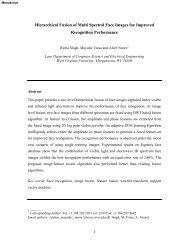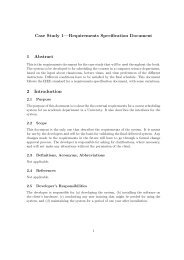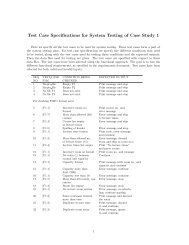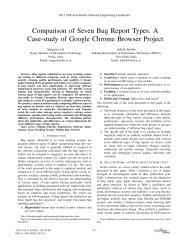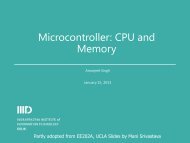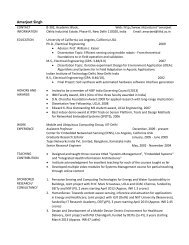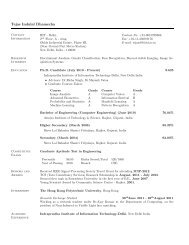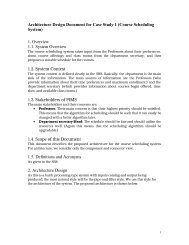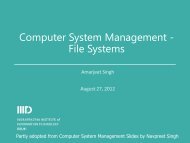Comparison of iris recognition algorithms - Intelligent ... - CiteSeerX
Comparison of iris recognition algorithms - Intelligent ... - CiteSeerX
Comparison of iris recognition algorithms - Intelligent ... - CiteSeerX
Create successful ePaper yourself
Turn your PDF publications into a flip-book with our unique Google optimized e-Paper software.
authentic person and 100% rejection rate for fake?. Wanger. al. [ 121 used Gabor filters and 2-D wavelet transformsfor feature extraction. For identification weighted Euclideandistance classification has been used. This method is invariantto translation and rotation and tolerant to illumination.The classification rate on using Gabor is 98.3% and theaccuracy with wavelets 82.51%. Robert et. al. [13] introducednew algorithm for localization and extraction <strong>of</strong> <strong>iris</strong>.For localization a combination <strong>of</strong> the integro-differentialoperators with a Hough Transform is used and for featureextraction the concept <strong>of</strong> instantaneous phase or emergentfrequency is used. Iris code is generated by thresholdingboth the models <strong>of</strong> emergent frequency and the real andimaginary parts <strong>of</strong> the instantaneous phase. Finally thematching is performed using Hamming distance. Resultsgave 11% <strong>of</strong> the false reject rate was obtained. Lim et. al.[ 141 used Haar Wavelet transform to extract features from<strong>iris</strong> images. By applying the transform four times on image<strong>of</strong> size 450x60 and combining the features 87 bit featurevector was obtained. This feature vector is the compactrepresentation <strong>of</strong> the <strong>iris</strong> image. Finally for classification <strong>of</strong>feature vectors, weight vector initialization and winner selectionstrategy has been used. The <strong>recognition</strong> rate obtainedis around 98.4%. In [16] two new methods <strong>of</strong> thestatistical and computer evaluations <strong>of</strong> the <strong>iris</strong> structure <strong>of</strong> ahuman eye in view <strong>of</strong> personal identification have beenproposed which are based partly on the correlation analysisand partly on the median binary code <strong>of</strong> commensurableregions <strong>of</strong> digitized <strong>iris</strong> image. Similarly method <strong>of</strong> eye-<strong>iris</strong>structure characterization using statistical and spectralanalysis <strong>of</strong> color <strong>iris</strong> images is considered in [17]. Gurianovet.al. [I71 used Wiener spectra for characterization <strong>of</strong> <strong>iris</strong>patterns. In [lS, 201 human <strong>iris</strong> structure is explained andclassified using coherent Fourier spectra <strong>of</strong> the opticaltransmission.In [21], an efficient biometric security algorithm for <strong>iris</strong><strong>recognition</strong> system with high performance and high confidencehas been described. The system is based on an empiricalanalysis <strong>of</strong> the <strong>iris</strong> image and it is split in severalsteps using local image properties. The various steps arecapturing <strong>iris</strong> pattems; determining the location <strong>of</strong> <strong>iris</strong>boundaries; converting the <strong>iris</strong> boundary to the stretchedpolar coordinate system; extracting the <strong>iris</strong> code based ontexture analysis using wavelet transforms and classification<strong>of</strong> the <strong>iris</strong> code. The proposed system use the wavelet transformsfor texture analysis, and it depends heavily on theknowledge <strong>of</strong> general structure <strong>of</strong> human <strong>iris</strong>. The systemhas been implemented and tested using a dataset <strong>of</strong> 240samples <strong>of</strong> <strong>iris</strong> data with different contrast quality.COMPARISONWe have implemented four <strong>algorithms</strong> [5, 9, 13, 151 basedon Iris Code. The <strong>algorithms</strong> are implemented in MATLAB6.5. These <strong>algorithms</strong> have been tested on the CASIA IrisImage Database 1221 as this is the only database availablein public domain. Thc: database includes 756 <strong>iris</strong> imagesfrom 108 individuals. For each eye, 7 images are therewhich have been captured in two sessions; three samplesare collected in the first session and four in the second session.We have taken three images for training purpose andrest <strong>of</strong> the four for testing. The performance results arebased on error rates: False Acceptance Rate (FAR) andFalse Rejection Rate (FRR); and the overall accuracy. Thepercentage accuracy based on FAR and FRR <strong>of</strong> the implemented<strong>algorithms</strong> is shown in Table 1. This table showsthat the Daugman’s algorithm [15] gives the maximum accuracyamong the four.Table 1. Performance <strong>of</strong> AlgorithmsAlgorithmOverall 70FAIUFRR[Reference]AccuracyAvila [5] 0.0312.080.02/ 1.98Tisse [ 131 1.8418.7999.90Figure 2 shows a comparison among the <strong>algorithms</strong>. In thisexperiment we have compared the FAR, FRR and overallaccuracy <strong>of</strong> the <strong>algorithms</strong> to each other, i.e. FAR for 1 iscompared to FAR <strong>of</strong> 2, 3 and 4 and in all [ 151 gives the bestperformance.AlgorithmFigure 2. <strong>Comparison</strong> <strong>of</strong> Error Rates and Accuracy <strong>of</strong>Algorithms.356 IClSlP 2004



